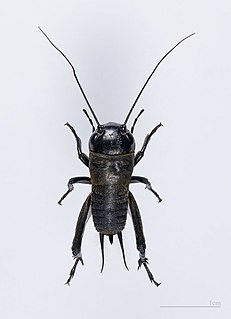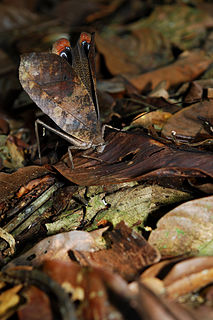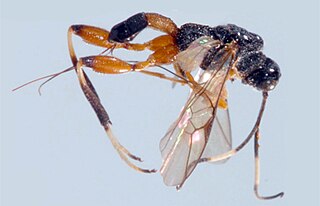
Insects in the family Tettigoniidae are commonly called katydids, or bush crickets. They have previously been known as "long-horned grasshoppers". More than 6,400 species are known. Part of the suborder Ensifera, the Tettigoniidae are the only extant (living) family in the superfamily Tettigonioidea.

The ovipositor is a tube-like organ used by some animals, especially insects, for the laying of eggs. In insects, an ovipositor consists of a maximum of three pairs of appendages. The details and morphology of the ovipositor vary, but typically its form is adapted to functions such as preparing a place for the egg, transmitting the egg, and then placing it properly. For most insects, the organ is used merely to attach the egg to some surface, but for many parasitic species, it is a piercing organ as well.

Ensifera is a suborder of insects that includes the various types of crickets and their allies including: true crickets, camel crickets, bush crickets or katydids, grigs, weta and Cooloola monsters. This and the suborder Caelifera make up the order Orthoptera. Ensifera is believed to be a more ancient group than Caelifera, with its origins in the Carboniferous period, the split having occurred at the end of the Permian period. Unlike the Caelifera, the Ensifera contain numerous members that are partially carnivorous, feeding on other insects, as well as plants.

Heteropteryx is a monotypic genus of stick insects containing Heteropteryx dilatata as the only described species. and gives its name to the family of the Heteropterygidae. Their only species may be known as jungle nymph, Malaysian stick insect, Malaysian wood nymph, Malayan jungle nymph, or Malayan wood nymph and because of their size it is commonly kept in zoological institutions and private terrariums of insect lovers. It originates in Malay Archipelago, more precisely on the Malay Peninsula and Borneo and is nocturnal.

Saga pedo is a species of bush cricket, spread throughout the European part of the Mediterranean, and Asia as far east as China. It is a wingless bush cricket, with the body size of up to 12 centimetres (4.7 in), which makes it one of the largest European insects and one of the world's largest Orthoptera. Colloquially known as the predatory bush cricket, or the spiked magician, it is uncommon among its kind due to its carnivorous lifestyle, most often preying on smaller insects, with a known tendency towards cannibalism as well. For this purpose, it has strong fore and mid legs, equipped with sharp spines. When these animals are hunting, they move about, catching their prey by suddenly leaping on them and grabbing them with their legs. Their prey is usually killed by biting into the throat, and eating is done at capture. Saga pedo is active at dusk and during nighttime, with activity slowly expanding through the day at the end of the season.

Meconema thalassinum is an insect in the family Tettigoniidae known as the oak bush-cricket and drumming katydid. It is native to Europe, including the British Isles, and was introduced to the United States, first established in the west of Long Island and extending its range to Rhode Island and Scarsdale, Stony Brook, and Ithaca, New York.

Tettigonia viridissima, the great green bush-cricket, is a large species of bush-cricket belonging to the subfamily Tettigoniinae.

Crickets are Orthopteran insects which are related to bush crickets, and, more distantly, to grasshoppers. In older literature, such as Imms, "crickets" were placed at the family level, but contemporary authorities including Otte now place them in the superfamily Grylloidea. The word has been used in combination to describe more distantly related taxa in the suborder Ensifera, such as king crickets and mole crickets.

Xanthocryptus novozealandicus, the lemon tree borer parasite, is a wasp in the family Ichneumonidae. It is a native insect of New Zealand. It is also found in Australia and New Guinea. Females hunt for larvae of wood-boring beetles around March, including the lemon tree borer, a native cerambycid that tunnels into citrus trees, grapes and many native species. When a suitable host is found, the female pushes her ovipositor through the wood and injects her eggs into the grub. This has the incidental benefit of helping to control some pests. X. novozealandicus prefers to prey on second year lemon tree borer larvae. This specific parasite prefers to prey on larger second year larvae due to its larger size.

Pterochroza ocellata, the peacock katydid, is an insect in the family Tettigoniidae. The species is a leaf-mimic katydid; when it is in repose its camouflage resembles a diseased or dead leaf. The katydid owes both its common name and its specific epithet to its startle display, in which it shows false eye spots on its normally hidden hind wings.

Tylopsis lilifolia, the lily bush-cricket, is a species of katydid in the subfamily Phaneropterinae. It is found in Europe and Asia.
Panoploscelis is a genus of very large insects belonging to the true katydid tribe Eucocconotini, which is a subfamily of the katydids. Like the other members of the suborder Ensifera, Panoploscelis are part of the insect order Orthoptera, which also contains crickets, grasshoppers and locusts. Members of this genus are among the largest katydids of the Neotropics.

The Saginae, commonly known as the predatory katydids or predatory bush-crickets, is a subfamily of the family Tettigoniidae. They are mostly found in Europe, west and central Asia and southern Africa.

Spasskia brevicarinata is a species of parasitoid wasp native to the Guizhou and Yunnan provinces of China. The female body is 8.2 millimeters long, with 7.3 millimeter forewings. The ovipositor, when fully extended, measures 5.5 millimeters long. General coloration is black, however, the first tergite is yellow. The fore and mid legs are also yellow, while the hind pair are reddish-brown and whitish-yellow. The antennae are dark brown, with a whitish-yellow stripe between the 11th and 15th flagellomeres No males of the species have been observed to date. The species name is derived from Latin brevi, meaning "short" and carinata, the word for "carina". This literally means that the species has a short dorsal carinae as part of the first tergite.

Conocephalus strictus, the straight-lanced meadow katydid, is a species of katydid found in North America.

Conocephalus fasciatus, the slender meadow katydid, is a species of katydid of the family Tettigoniidae that is native to the United States and Canada.

Orchelimum vulgare, otherwise known as the common meadow katydid, is a species of Orthoptera found in the central and eastern regions of North America. They are active from mid summer to fall.
Orchelimum fidicinium, the seaside meadow katydid, is a species of meadow katydid in the family Tettigoniidae. It is found in North America.
Orchelimum silvaticum, the long-spurred meadow katydid, is a species of meadow katydid in the family Tettigoniidae. It is found in North America.

Caedicia simplex is a species of bush cricket, native to New Zealand. It is also found in Australia. Its common name is the common garden katydid.
















